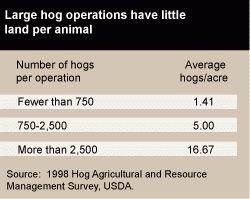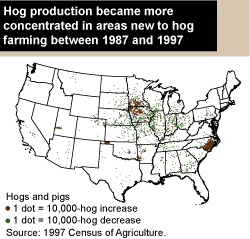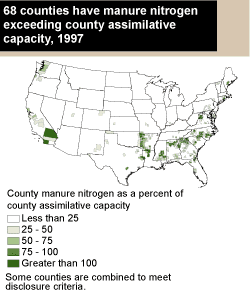Managing Manure: New Clean Water Act Regulations Create Imperative for Livestock Producers
- by Marc Ribaudo
- 2/3/2003
Nutrients from livestock and poultry manure are key sources of water pollution. Since regulations for livestock and poultry operations under the 1972 Clean Water Act were first developed, operations in general have become more concentrated and specialized. Ever-growing numbers of livestock and poultry per farm and per acre have increased the risk of water pollution, with manure being disposed of in ways not adequately addressed in the original regulations. In 2001, the Environmental Protection Agency (EPA) proposed new regulations that would compel operations with the largest number of animals to manage their manure according to a nutrient management plan. These regulations were signed by the Administrator of EPA on December 15, 2002, and are expected to be implemented in 2003.
These regulations were signed by the Administrator of EPA on December 15, 2002, and are expected to be implemented in 2003. The new regulations were called for in the Unified National Strategy for Animal Feeding Operations, developed jointly in 1999 by USDA's Natural Resources Conservation Service and EPA. The Strategy outlined USDA and EPA actions to minimize water quality and public health impacts from improperly managed animal manure. Much of the Strategy's focus was on the largest animal feeding operations. For smaller operations, a nutrient management plan would be recommended but not required.
Hog Production Exemplifies Industry Changes
Hog production provides a good example of how economic factors can change animal industry structure and practices, and how these changes might affect the environment. During the 1990s, the average number of hogs per operation increased and many new operations broke away from the traditional crop-livestock farm setting. Growth in the number of hogs per farm was driven by technological and organizational innovations that enabled producers to realize economies of size and lower production costs, but also resulted in much more manure to handle, store, and dispose of properly. The increase in intensity and size of operations resembles what happened to poultry farming in the 1950s and 1960s, and what is currently happening to lesser degrees in dairy and feedlot beef production.
Technological Innovations. In the past 20 years, improved breeding and genetics have resulted in pigs that produce leaner meat more appealing to consumers. Improvements in health, reproductive management, housing, and environmental management increased the number of pigs that reach market weight per breeding sow. Pigs born and weaned per litter increased by 8 and 12 percent between 1992 and 1998. Meanwhile, improvements in feed and nutrition reduced the amount of feed required to achieve a particular gain in weight. The feed efficiency of U.S. hog production improved by more than 20 percent between 1992 and 1998. The increase in profits obtainable with these new technologies and practices has been the driving force behind their adoption. Consequently, average production costs per hundredweight of gain were about 16 percent lower in 1998 than in 1992.
Organizational Innovations. New technologies and practices promise greater profits, but their implementation can require significant capital. Through contract arrangements and other organizational innovations, growers are better able to access the capital needed for such innovative technologies and to garner economies of size. As a result, marketing and production contracts now pervade the hog industry. Marketing contracts between large producers and processors typically specify that the producer will deliver a certain quantity of hogs at a certain time. Production contracts are between a contractor, typically a large producer or processor, and a grower. Under the terms of production contracts, the contractor provides management services, feeder pigs, veterinary services, and other inputs. The grower provides land, facilities, and labor.
Larger, More Specialized Operations. Until the late 1980s, hogs were typically raised from farrow (birth) to finish (ready for slaughter) on a crop-livestock farm, where feed was grown largely on the farm. All phases of production were contained on one operation. Today, hogs are increasingly produced on large, specialized operations that buy most feed and use the latest technologies to reduce production risk.
Between 1994 and 2001, the number of U.S. hog farms dropped by 60 percent, from over 200,000 to just above 80,000. Total U.S. hog inventories, though, remained at about 60 million head. Consequently, the share of the hog/pig inventory on operations with 2,000 head or more increased from 37 percent in 1994 to nearly 75 percent in 2001. The largest operations, with 5,000 head or more, housed half of hog inventories in 2001.
Increasing hog numbers were not matched with increasing acreage. The largest operations average 16.7 hogs per acre, compared with only 1.4 hogs per acre for small operations. The hog industry is trying to come to grips with too many animals on too few acres. Spreading manure on nearby land is the primary disposal method. If manure is spread at an appropriate rate, crops will assimilate most of manure's nutrients. When manure nutrients exceed crop uptake, nutrients and organic matter build up in the soil and can pollute water resources through runoff or leaching.
Accompanying this rapid growth in hogs per farm has been increasing specialization. The farrow-to-finish operations with fewer than 1,000 hogs/pigs that were common in the 1970s and 1980s fell from 78 percent of all hog farms in 1978 to 35 percent in 1995. The large-scale, commercial operations that emerged in the 1990s often specialize in one phase of production (see box Specialized Hog Operations).
Regional Concentration. As hog operations grew in size and became more specialized, they also clustered regionally to facilitate the transportation of animals among facilities in the supply chain, often linked by contracts. Hog production has historically been concentrated in Corn Belt States where an abundant supply of corn provided a relatively cheap source of feed. But now new regional concentrations have emerged in the Southeast and the Southwest. These producers have been able to compete with traditional Corn Belt producers by implementing new technologies more quickly and fully from scratch rather than by upgrading existing production facilities and management skills, as would occur in the Corn Belt. Some States, such as North Carolina, offered financial incentives to attract new industries. Hog inventories there more than tripled between 1989 and 1997, compared with a 5-percent increase nationwide.
Manure Rich. The average amount of cropland operated by U.S. hog producers dropped by 20 percent from 1992 to 1998 as producers increasingly favored purchased feed over farm-grown crops. As a result, large, specialized operations—with an average of 16.7 hogs per acre of cropland on the farm versus 1.4 hogs for small operations—are mostly unable to reasonably dispose of manure nearby. The crops receiving manure on large farms cannot generally assimilate the manure's nutrients. An estimated 51 percent of nitrogen and 64 percent of phosphorus—both potentially harmful to water quality—in manure from confined hog operations nationwide exceeds onsite crop needs. And most of that excess occurs on large farms. The largest 2 percent of U.S. hog farms control only 2 percent of land on hog farms but produce 53 percent of the total excess nitrogen in hog manure and half the total excess phosphorus.

The Bigger Picture: Not Just Hogs
The manure problem goes beyond hogs to cattle, dairy, and poultry as well. The number of animals per acre of available cropland and pastureland controlled by confined operations increased 60 percent between 1982 and 1997. Many livestock and poultry operations do not use all of the land they do have for spreading manure, Manure is heavy and costly to transport, so producers often apply more manure than crops can use on fields nearest the production facility. With larger livestock and poultry farms, increasing numbers of animals per acre, and regional clustering, water quality problems have arisen in some areas.
The U.S. Geological Survey identifies confined animal feeding operations as a significant factor behind poor water quality in several areas of the country. Manure lagoon spills or leaks have occurred recently in a dozen States. In 1995, a lagoon break on a large hog operation in Jacksonville, NC, spilled more than 20 million gallons of waste into the New River, causing a massive fish kill. Maryland and North Carolina officials cited nitrogen and phosphorus from poultry and hog manure as a contributor to recent outbreaks of the toxic dinoflagellate pfiesteria.
Nutrient Management Plans Proposed
Under the 1972 Clean Water Act, animal feeding operations over a certain size (2,500 hogs, 1,000 beef cattle, 700 dairy cows, 100,000 chickens) are designated concentrated animal feeding operations (CAFOs) subject to the National Pollutant Discharge Elimination System (NPDES) permit program. The permits specify a level of treatment for each pollutant at its source. However, a major shortcoming of this program with regard to manure nutrients was its focus solely on the animal confinement area, presuming that manure nutrients removed from that area would not be excessively applied to crops or land and potentially cause water quality problems elsewhere.

EPA and USDA addressed this shortcoming in the Unified National Strategy for Animal Feeding Operations, which has played a large part in EPA regulatory updating. The Strategy is based on a national performance expectation that each animal feeding operation should develop and implement a technically sound, economically feasible, and site-specific comprehensive nutrient management plan for properly managing the animal manures produced at the facility, including onfarm application and off-farm disposal. The Strategy states that land application is the most desirable method of utilizing manure because of the value of the nutrients and organic matter. Each operation's nutrient management plan would be tailored to address its individual needs and practices, including the nutrient assimilative capacity of the crops being grown on available land. The plan would be based on either nitrogen or phosphorus, depending on local conditions. Under EPA's new regulations, CAFOs applying manure to land must develop and implement a nutrient management plan. Other animal feeding operations would be encouraged to develop and implement plans voluntarily.
Developing and implementing nutrient management plans that limit manure nutrient application to crop needs would entail widely varying costs among farms. Manure application limits would likely cause large animal facilities to seek and use more land for spreading manure or to find alternative use technologies. These operations would have to absorb added costs from developing a nutrient management plan, testing manure for nutrients, hauling manure longer distances, and applying manure to more land. For example, the average large hog operation (>2,500 head) in the Mid-Atlantic States would have to increase the amount of land used for spreading from 69 acres to 398 acres in order to meet a nitrogen-based application standard. The additional cost of meeting the standard could range from $1,450 to $32,500 per operator per year, depending on the willingness of landowners not producing livestock to accept manure. For operations with adequate land onsite, the additional cost of compliance is not likely to be prohibitive. Costs might increase greatly if land off the farm is needed for manure application.
Regional differences in land use would greatly affect manure management costs if land off the farm has to be found for spreading manure. For example, ERS analysis suggests that the average cost of complying with a nitrogen-based plan for large hog operations in the Mid-Atlantic region could be nine times higher per animal than in the Corn Belt. Large hog farms in the Corn Belt tend to have more land available for spreading, so that only 44 percent would have to spread off the farm, compared with 83 percent in the Mid-Atlantic. In addition, crop production is more prevalent in the Corn Belt: about 70 percent of land in Corn Belt counties with confined hog facilities is suitable for spreading manure, versus 20 percent of land in the Mid-Atlantic. This means that hog operations in the Mid-Atlantic are more likely to have to transport manure longer distances to reach an adequate land base.
Finding enough land for spreading manure may be virtually impossible in some areas where animal concentrations are highest. In 68 U.S. counties (primarily in North Carolina, northern Georgia, Alabama, central Mississippi, western Arkansas, and California), manure nitrogen from all confined livestock and poultry operations is estimated to exceed the total nitrogen needs of the county's crop and pasture land. Many more counties (152) have county-level excesses of phosphorus, mainly in western Virginia, Delaware and eastern Maryland, eastern North Carolina, northern Georgia and Alabama, central Mississippi, western Arkansas, and southern California. Competition among animal operations for available offsite land in these areas and others with relatively high concentrations of animals would increase the cost of manure disposal.
Who Pays, and How To Pay Less
Who should be responsible for manure management when production contracts are used to coordinate phases of production? For example, large hog producers often establish production contracts with smaller growers to feed the hogs to market weight. The producer provides the pigs, management services, feed, and other inputs, while the grower provides the labor and facilities. The producer owns the animals, but the manure is produced at the grower's facility. Under EPA's new regulations, the grower would be solely responsible for managing manure. However, some groups feel that charging both the contracting producer and the grower with manure management would better facilitate the changes needed to meet new requirements.
Land application alone may be insufficient to economically handle all generated nutrients in some areas, without changing the structure or scale of the local animal industry. Some emerging technologies could help with the disposal. Poultry litter is being turned into commercial fertilizer products in Virginia and Maryland. Manure nutrients in the form of commercial fertilizer can be more economically shipped than 'natural' manure and are in higher demand (on golf courses, for example).
Livestock and poultry feed can be managed to reduce the nutrient content of manure, making it easier to follow a nutrient management plan. For example, some poultry and hog producers are using feed treated with the enzyme phytase to reduce the phosphorus content of manure by up to 45 percent.
Another emerging technology for using manure is energy production. A power plant in Minnesota currently burns poultry litter. However, the cost of producing energy from litter is estimated at three to four times the cost of conventional power generation. Under different economic conditions, manure use in power generation could be feasible where a high concentration of livestock or poultry provides a ready source of fuel.
A fertilizer, energy, or industrial waste treatment facility could encourage even greater regional concentration of animal operations by simplifying the manure disposal problem. Depending on the cost of treatment, animal operations may find it cheaper to ship manure to such a facility than to spread it on land. Increased regional concentration of animal production could worsen odor and disturb neighboring communities, but water quality problems would be mitigated as long as spills and storage failures were avoided.
No Cheap Way Out
Economic factors have reshaped the animal sector, largely without influence from environmental regulation. Large, specialized facilities have emerged, linked by contractual arrangements to reap economies of size. These changes have also escalated a manure management problem that earlier water quality regulations addressed inadequately.
Land application of manure nutrients is the most widely practiced method of disposal. USDA is advocating manure management practices that limit application rates to more closely match what the land and planted crops can assimilate. Implementing nutrient management plans will likely raise the costs of manure management, especially for large facilities with little land.
Such operations have four major response options if required to follow a nutrient management plan. One response is to find more land in the general area for spreading manure. Another option is to move operations to areas with more land and lower regional animal concentrations. A third response is to find alternative feed and manure management practices that reduce manure nutrient content. Finally, operations can either sell or give manure to industrial processes if firms can be attracted to the area. Whether the additional costs of managing manure will significantly alter the current concentrated and integrated structure of livestock and poultry production remains to be seen.
This article is drawn from:
- McBride, W.D. & Key, N. (2003). Economic and Structural Relationships in U.S. Hog Production. U.S. Department of Agriculture, Economic Research Service. AER-818.
- Ribaudo, M., Gollehon, N., Aillery, M., Kaplan, J., Johansson, R., Agapoff, J., Christensen, L., Breneman, V. & Peters, M. (2003). Manure Management for Water Quality: Costs to Animal Feeding Operations of Applying Manure Nutrients to Land. U.S. Department of Agriculture, Economic Research Service. AER-824.
- Manure Nutrients Relative to the Capacity of Cropland Pastureland to Assimilate Nutrients: Spatial and Temporal Trends for the United States. (2000). Natural Resources Conservation Service and ERS, NPS00-0579.
You may also like:
- Conservation Programs. (n.d.). U.S. Department of Agriculture, Economic Research Service.




